Reflection and Refraction
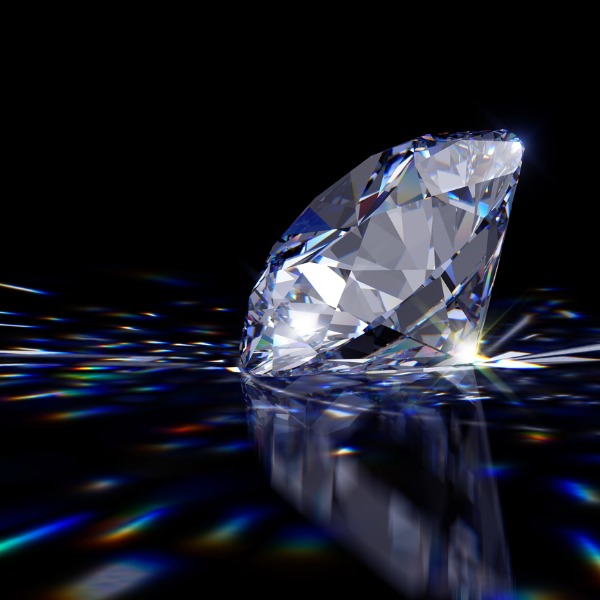
Large diamond refracting light (DiamondGalaxy, iStockphoto)

Large diamond refracting light (DiamondGalaxy, iStockphoto)
How does this align with my curriculum?
Learn about reflection and refraction and meet Emily Altiere, a PhD student in physics who studies lasers.
Reflection

Image - Text Version
Shown is a colour photograph of a city at night, and its reflection in water.
High rise office buildings are close together along the horizon. Their windows twinkle with light. The CN Tower is to the left, lit up in red. All the buildings and their lights are reflected, upside down, in the calm water in the foreground. The water, and the sky above are both dark blue.
Reflection occurs when light traveling through one material bounces off a different material. The reflected light continues to travel in a straight line, but in a different direction.
Here are some things to remember about reflection.
- Light is reflected at the same angle that it hits the surface.
The angle between the incoming light and a line perpendicular to the surface we call the angle of incidence. The angle between the reflected light and a line perpendicular to the surface we call the angle of reflection. The perpendicular line we call the normal. - The angle of incidence is equal to the angle of reflection.
The symbol Ɵ means “angle'' and arrows represent rays of light.

Image - Text Version
Shown are two colour illustrations of the angles of light reflecting off surfaces.
Both illustrations have a long, flat, grey rectangle along the bottom edge. These are labelled "Surface." Vertical, dashed lines stretch down the centre of each illustration, ending at the top centre of each rectangle. These lines are labelled, "Normal."
In the left illustration, a blue arrow points diagonally, down and right, to top centre of the surface. This is labelled "Incident Light" in blue letters. A red arrow points diagonally up and right from the top centre of the surface. This is labelled, "Reflected Light" in red letters.
A curved line leads from
"Normal" out to each of the arrows. The one leading to the "Incident Light" arrow is labelled with a theta symbol and a lower case, italicized i. The one leading to the "Reflected Light" arrow is labelled with a theta symbol and a lowercase, italicized r.
The right illustration is the same as the left, except that the angles of the arrows are further away from "Normal". Each of these angles are also labelled with the theta symbol and a lowercase, italicized i, and the theta symbol and a lowercase, italicized r.

Image - Text Version
Shown is a colour diagram of light reflecting off a smooth surface.
A long, flat, grey rectangle runs along the bottom edge of the illustration. This is labelled, "Surface." Three blue, parallel arrows point diagonally down to the top of the rectangle. Where the blue arrows touch the surface, three red arrows point diagonally up at the same angle. These look like three V shapes.
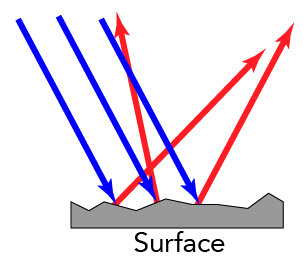
Image - Text Version
Shown is a colour diagram of light reflecting off a rough surface.
Along the bottom of the diagram is a long grey shape, with a flat bottom edge and a jagged, uneven top edge. This is labelled, "Surface."
Three diagonal, parallel blue arrows point down to the surface. Where each arrow touches the surface, a red arrow points up. These are at three completely different angles.
A good example of specular and diffuse reflection is when the headlights vehicles shine on the road at night.
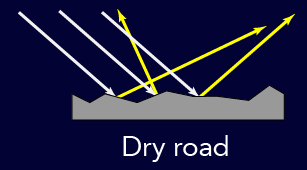
Image - Text Version
Shown is a colour diagram of light reflecting off a rough surface.
The background of the diagram is dark blue. Along the bottom is a long grey shape, with a flat bottom edge and a jagged, uneven top edge. This is labelled, "Dry road."
Three diagonal, parallel white arrows point down to the surface. Where each arrow touches the surface, a yellow arrow points up. These arrows point in three different directions, at different angles.
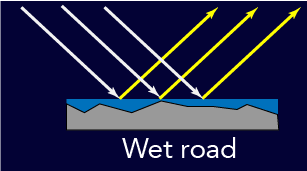
Image - Text Version
Shown is a colour diagram of light reflecting off a rough surface.
The background of the diagram is dark blue. Along the bottom is a long grey shape, with a flat bottom edge and a jagged, uneven top edge. This jagged surface is covered with a smooth, blue, stripe, creating a flat top surface. This is labelled, "Wet road."
Three diagonal, parallel white arrows point down to the surface. Where each arrow touches the surface, a yellow arrow points up at the same angle. The two sets of arrows resemble three V shapes.
Refraction
Not only can light bounce off materials, it can also sometimes travel through materials. When light travels through a uniform material, like air, it goes in straight lines. When light travels through one material and into a second material, interesting things happen!

Image - Text Version
Shown is a colour photograph of light refracted through a lens marked with angles.
At the centre of the image is a circle marked around the edge with degrees in each quarter. In the lower half of this circle is a half-circle of clear, shiny material.
A narrow beam of light extends from the end of black cylinder in the top left corner of the photograph. The beam crosses the 60 degree mark of the top left quarter of the circle. This beam is labelled "Incident light."
When the light hits the edge of the lens, it goes in two different directions.
One faint beam turns diagonally down through the lens at about 35 degrees. This beam is labelled "Refracted light."
Another, even fainter beam turns up, diagonally away from the edge of the lens, through the 60 degree mark in the top right quarter of the circle. This beam is labelled "Reflected light."
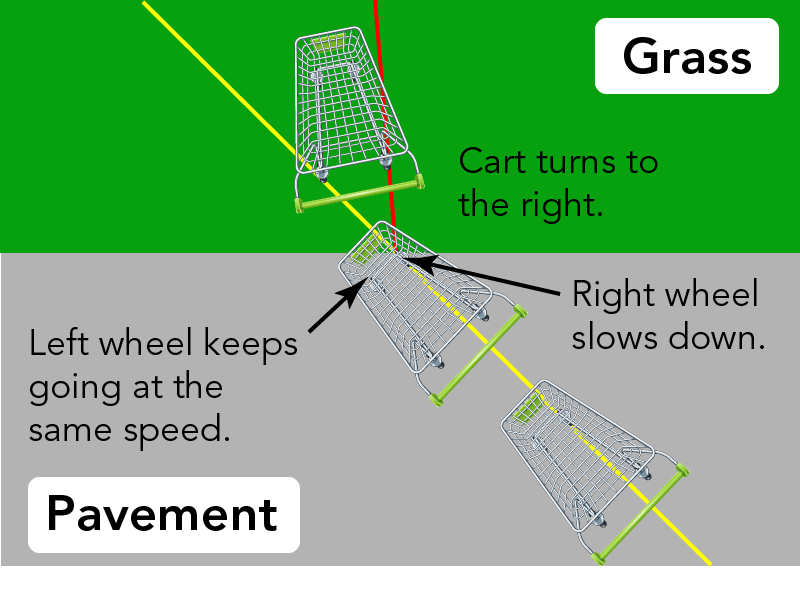
Image - Text Version
Item contShown is a colour diagram of a shopping cart moving from pavement onto grass.
The bottom two thirds of the image is grey. This is labelled "Pavement." The top is green and labelled "Grass." A straight yellow line stretches across the illustration, from near the lower right corner, to near the upper right corner.
Two shopping carts are shown from above, along the yellow line. This illustrates that one cart is moving in a straight line, across the grey pavement, toward the grass.
The front right corner of the second cart is on the green background, while the rest is on the grey. The front right wheel is labelled "Right wheel slows down." The front left wheel of the cart is labelled "Left wheel keeps going at the same speed."
A third cart is completely on the green background. It does not follow the yellow line of the other two.There is a red line under this cart, leading from the edge of the pavement, to a point near the top centre of the illustration. This cart is labelled "Cart turns to the right."ent
Index of Refraction
The way light changes directions has to do with the properties of the material it is travelling through. Every material has a unique index of refraction. This measurement is identified using the letter n.
The index of refraction of a material is equal to the speed of light in a vacuum, divided by the speed of light in the material. The higher the index of refraction, the slower light travels in that medium.
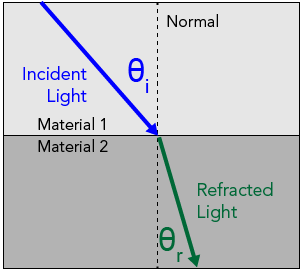
Image - Text Version
Shown is a colour diagram of light bending as it refracts through material.
The upper half of the diagram has a light grey background. This is labelled, "Material 1." The lower half has a darker grey background. This is labelled, "Material 2."
A dashed, black, runs vertically through the centre of the diagram. This is labelled "Normal".
A blue arrow points diagonally from the left side of the top edge of the diagram, through Material 1, to the point where normal crosses from Material 1 to Material 2. This is labelled "Incident Light." It is marked with the theta symbol and the letter i to indicate it depicts the angle of incident light.
A green arrow points from here, diagonally through Material 2, to the right part of the lower edge of the diagram. This arrow is labelled "Refracted Light." The space between the arrow and normal is marked with the theta symbol and the letter r to indicate this is the angle of refracted light.
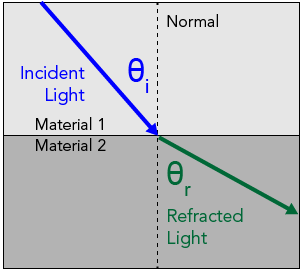
Image - Text Version
Shown is a colour diagram of light bending as it refracts through material.
The upper half of the diagram has a light grey background. This is labelled, "Material 1." The lower half has a darker grey background. This is labelled, "Material 2."
A dashed, black, runs vertically through the centre of the diagram. This is labelled "Normal".
A blue arrow points diagonally from the left side of the top edge of the diagram, through Material 1, to the point where normal crosses from Material 1 to Material 2. This is labelled "Incident Light." It is marked with the theta symbol and the letter i to indicate it depicts the angle of incident light.
A green arrow points from here, diagonally through Material 2, to the lower part of the right edge of the diagram. This arrow is labelled "Refracted Light." The space between the arrow and normal is marked with the theta symbol and the letter r to indicate this is the angle of refracted light.
Unlike reflection, the angle of incidence is not equal to the angle of refraction.
This relationship between the angle of incidence and angle of refraction are known as Snell’s Law.
Converging and Diverging Light
We can make light go in different directions using lenses. A lens is an optical device made of plastic or glass. When light passes through a lens, it can be refracted in predictable directions. The directions depend on the shape of the surfaces of the lens.
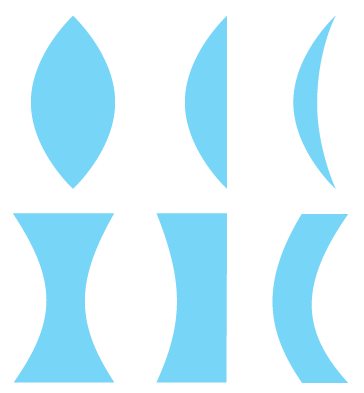
Image - Text Version
IShown is a colour illustration of six different blue, curved shapes.
In the top row, from the left, the first shape has two sides that are curved outward. In the second shape, the left side is curved outward, while the right side is flat. In the third shape, the left side is curved outward and the right side is curved inward.
In the bottom row, from the left, the right and left sides of the first shape are curved inward. In the second shape, the left side is curved inward, while the right side is flat. In the last shape, the left side is curved outward, while the right side is curved inward.
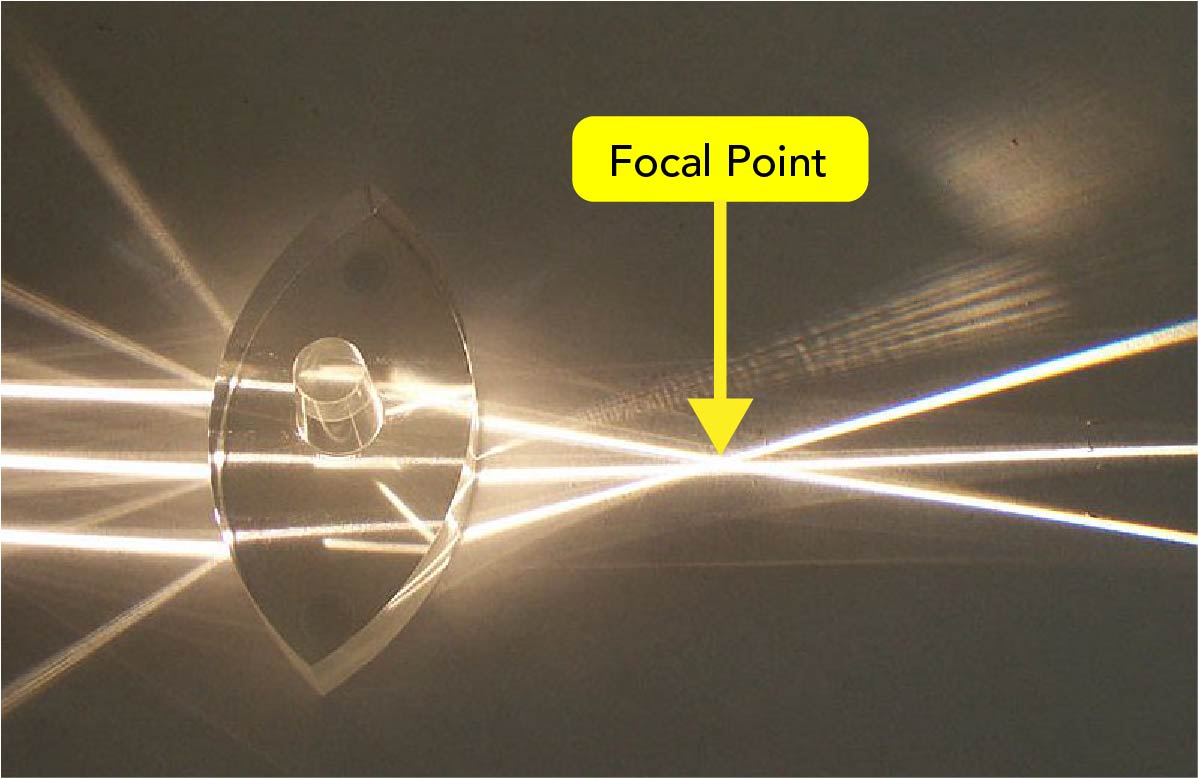
Image - Text Version
Shown is a colour photograph of three beams of light converging after passing through a lens.
The lens looks like the top left shape in the illustration above. It is clear, and has two sides that curve outward.
Three thin white beams of light shine from the left edge of the image. When they hit the edge left side of the lens, they turn in toward each other.
The beams continue at the same angles through the lens and out the right side. They meet and cross over each other at a point to the right of the lens. This is labelled "Focal Point" with a yellow arrow.
The light beams can also be seen reflecting, faintly off the left side of the lens. These diverge from each other.

Image - Text Version
Shown is a colour photograph of three beams of light diverging as they pass through a lens.
The lens looks like the bottom left shape in the illustration above. It is clear, and has two sides that curve inward.
Three thin white beams of light shine from the left edge of the image. When they hit the edge left side of the lens, they turn in outward, away from each other.
The beams continue at the same angles through the lens and out the right side.
The light beams can also be seen reflecting, faintly off the left side of the lens. Here, they turn in toward each other. They meet and cross over at a point to the left of the lens. This point is labelled "Focal Point" with a yellow arrow.
Light Through a Prism
Light entering a plastic or glass prism, refracts as it enters the prism and again as it exits the prism.
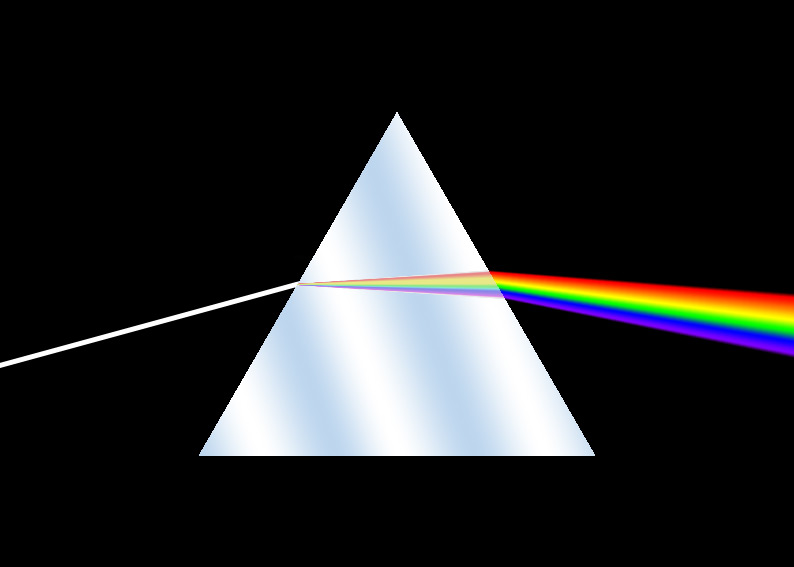
Image - Text Version
Shown is a colour illustration of a light beam passing through a prism.
The illustration has a large, pale grey, equilateral triangle on a black background.
A thin white line extends from the left edge of the image, to the right edge of the triangle. Here the line fans out into a rainbow of colours. Starting from the top, these are: red, orange, yellow, green, blue, indigo and violet. The rainbow grows wider as it moves through the prism and out the other side.
Learn More
What's in a Rainbow? (2019)
This article, by Let’s Talk Science, explains how a rainbow can form in the sky.
What is white light?
This hands-on activity, by Let’s Talk Science, shows how it is possible to combine colours to make white light.
References
Ducksters. (n.d.). Lenses and lights.
The Editors of Encyclopaedia Britannica. (n.d.). Refraction.
Encyclopaedia Britannica. (n.d.). Angle of reflection.
Florida State University. (n.d.). Specular and diffuse reflection.
Fore, M. (n.d.). Refraction: Definition, Snell's law & refractive index. Sciencing.
The Physics Classroom. (n.d.). Converging lenses: Ray diagrams.
The Physics Classroom. (n.d.). The law of reflection.